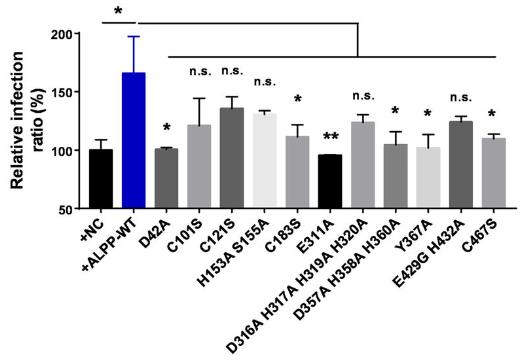Recombinant Human ALPP protein(Ile23-Asp506), His-tagged
| Cat.No. : | ALPP-219H |
| Product Overview : | Recombinant Human ALPP (AAH09647.1) (Ile23-Asp506) was expressed in Yeast with a polyhistidine tag at the C-terminus. |
- Specification
- Gene Information
- Related Products
- Case Study
- Application
- Download
| Species : | Human |
| Source : | Yeast |
| Tag : | His |
| Protein Length : | Ile23-Asp506 |
| Form : | Lyophilized from sterile 50 mM Tris-Acetate, 1 mM EDTA, 20 % glycerol, pH 7. 5. Normally 5 % - 8 % trehalose, mannitol and 0.01% Tween80 are added as protectants before lyophilization. |
| Molecular Mass : | The recombinant human ALPP consists of 494 amino acids and predicts a molecular mass of 54.1 KDa. It migrates as an approximately 66 KDa band in SDS-PAGE under reducing conditions. |
| Purity : | > 80 % as determined by SDS-PAGE |
| Storage : | Samples are stable for up to twelve months from date of receipt at -20°C to -80°C. Store it under sterile conditions at -20°C to -80°C. It is recommended that the protein be aliquoted for optimal storage. Avoid repeated freeze-thaw cycles. |
| Reconstitution : | It is recommended that sterile water be added to the vial to prepare a stock solution of 0.2 ug/ul. Centrifuge the vial at 4°C before opening to recover the entire contents. |
| Gene Name | ALPP alkaline phosphatase, placental [ Homo sapiens ] |
| Official Symbol | ALPP |
| Synonyms | ALPP; alkaline phosphatase, placental; alkaline phosphatase, placental (Regan isozyme); alkaline phosphatase, placental type; Regan isozyme; PLAP-1; glycerophosphatase; alkaline phosphomonoesterase; placental alkaline phosphatase 1; alkaline phosphatase Regan isozyme; ALP; PALP; PLAP; FLJ61142; |
| Gene ID | 250 |
| mRNA Refseq | NM_001632 |
| Protein Refseq | NP_001623 |
| MIM | 171800 |
| UniProt ID | P05187 |
| ◆ Recombinant Proteins | ||
| ALPP-67H | Recombinant Human ALPP Protein, His-tagged | +Inquiry |
| ALPP-30162H | Recombinant Human ALPP protein, GST-tagged | +Inquiry |
| ALPP-495H | Recombinant Human ALPP Protein, GST-tagged | +Inquiry |
| ALPP-2860C | Recombinant Cynomolgus ALPP protein, His-tagged | +Inquiry |
| ALPP-221H | Recombinant Human ALPP protein, T7/His-tagged | +Inquiry |
| ◆ Native Proteins | ||
| ALPP-8005H | Native Human Placental Alkaline Phosphatase | +Inquiry |
| ALPP-8347H | Native Human ALPP | +Inquiry |
| ◆ Cell & Tissue Lysates | ||
| ALPP-8893HCL | Recombinant Human ALPP 293 Cell Lysate | +Inquiry |
Case 1: Chen J, et al. mBio. 2020
When a mom-to-be catches the Zika virus, her baby could face growth problems or have a smaller head. Although researchers are still puzzled about how Zika gets around in the placenta, they have figured out that an enzyme called ALPP, mostly found in the placenta, helps the virus infect cells. ALPP hooks up with the virus's proteins, keeping them from breaking down and helping the virus grow and thrive. This all depends on ALPP doing its enzyme job. Plus, a protein named BIP, which helps cells manage stress, also supports the virus by helping ALPP connect with Zika's proteins. In short, ALPP and BIP team up to aid Zika in spreading through the placenta.

Fig1. Statistical analyses of ZIKV infection in wild-type ALPP- or alkaline phosphatase-impaired ALPP mutant-overexpressing cells.

Fig2. Western blot analysis of ALPP expression in WT and BIP−/− U-251 MG cells.
Case 2: Nonoyama S, et al. Cells. 2021
Human umbilical cord perivascular cells (HUCPVCs) are being looked at as a promising alternative to mesenchymal stromal cells. In this study, researchers explored the properties of alkaline phosphatase-positive HUCPVCs, or ALP(+)-HUCPVCs, which were generated by treating HUCPVCs with active vitamin D3 and inhibitors for certain growth factors. They looked at how they grow, their shape, and the genes they express. These cells show high activity of the ALP gene but don't grow very fast. They have a fibroblast-like shape with lots of actin filaments. Besides ALP, they also express higher levels of genes like type I collagen and osteopontin, suggesting a varied functionality. Although these cells don't promote mineralization like you'd expect in bone formation due to limited phosphate uptake, they might actually produce substances that prevent it.

Fig1. Effect of various factors on the ALP-inducing activity of HUCPVCs.

Fig2. ALP-inducing activity of PPU7 cultured with CM-HUCPVC.
The human ALPP protein, or alkaline phosphatase, plays a key role in critical body functions like bone building and metabolism. Mainly found in the placenta, it's also connected to some cancers, turning it into a hot topic in medical research. By delving into how ALPP works, researchers hope to better understand various health issues and even develop new treatments.
Recombinant human ALPP protein is valuable in research and industrial applications. In the lab, it's used to delve deeper into its physiological roles and how it might contribute to disease development and progression, particularly in cancer research. Industrially, it's pivotal in drug development processes, especially for conditions where modulation of alkaline phosphatase activity could be beneficial. By studying and utilizing this protein, scientists hope to pioneer targeted treatments and improve overall health outcomes.
Not For Human Consumption!
Inquiry
- Reviews
- Q&As
Ask a Question for All ALPP Products
Required fields are marked with *
My Review for All ALPP Products
Required fields are marked with *
Inquiry Basket


